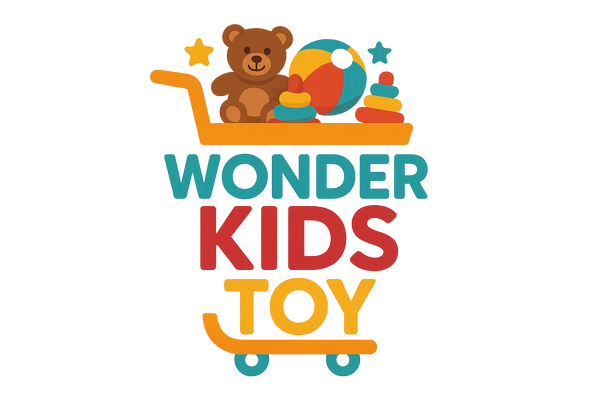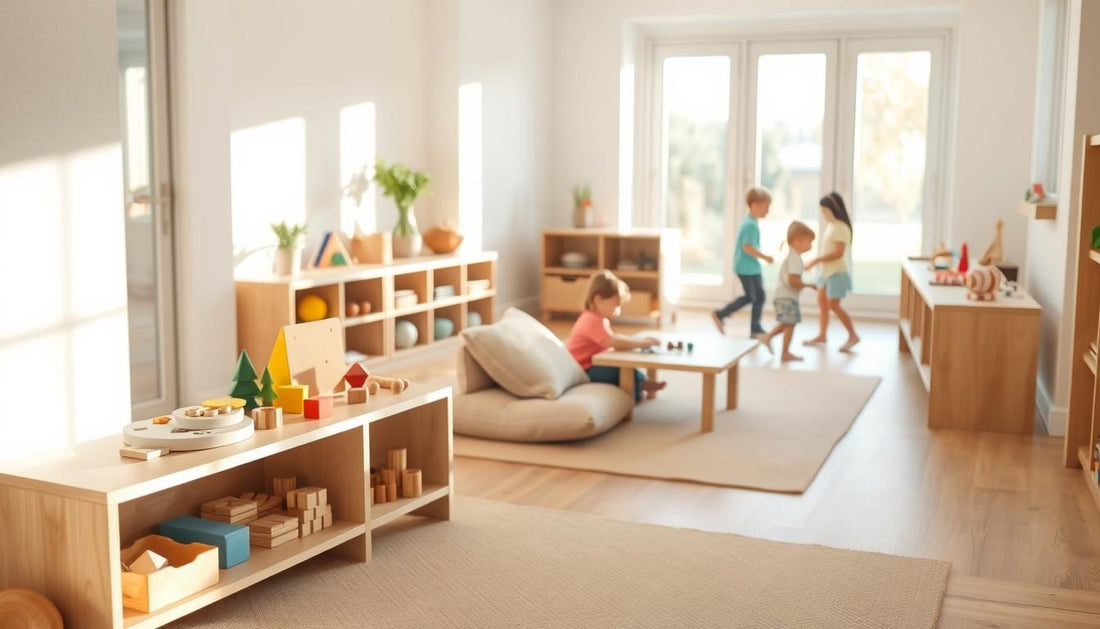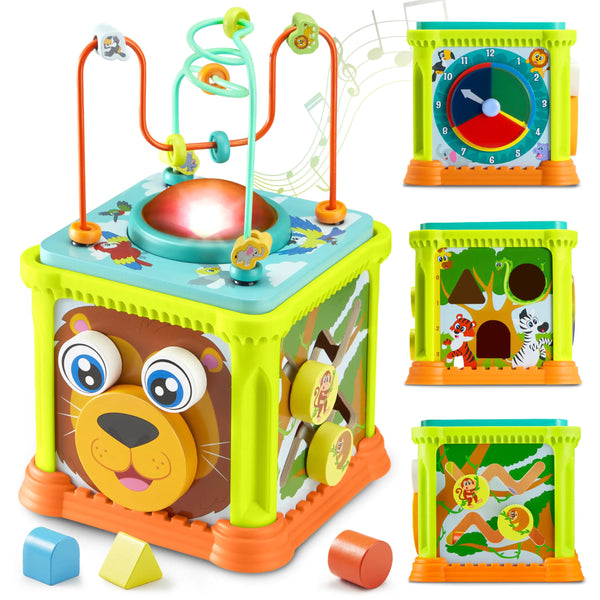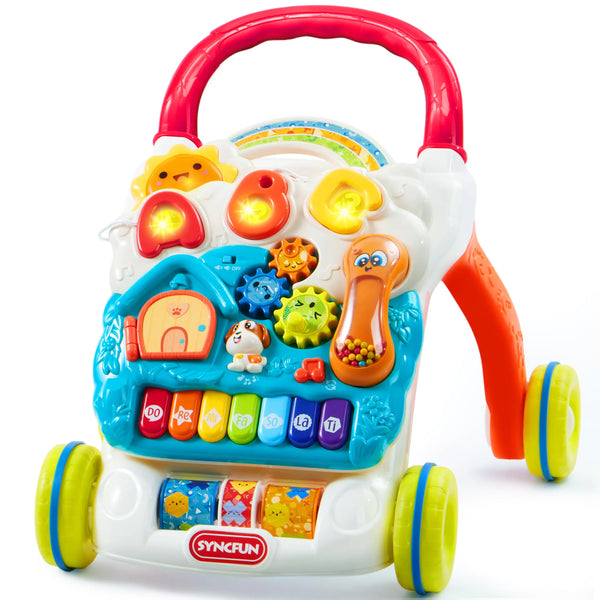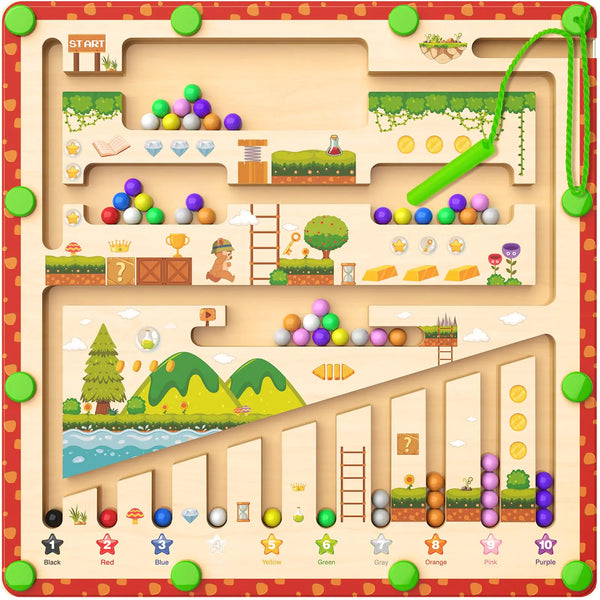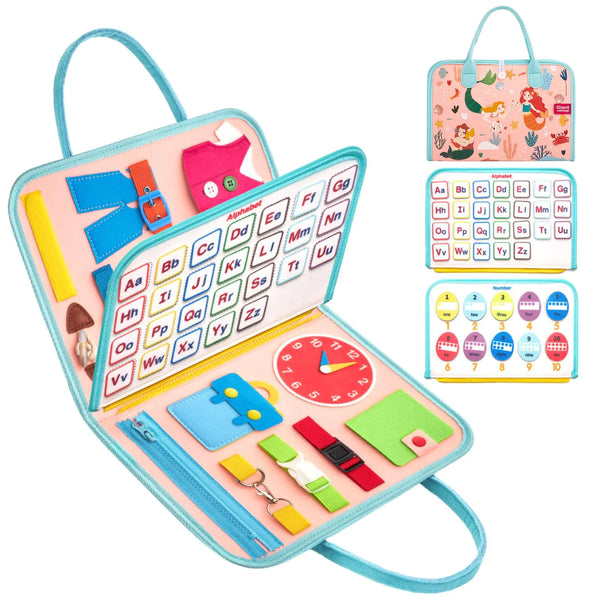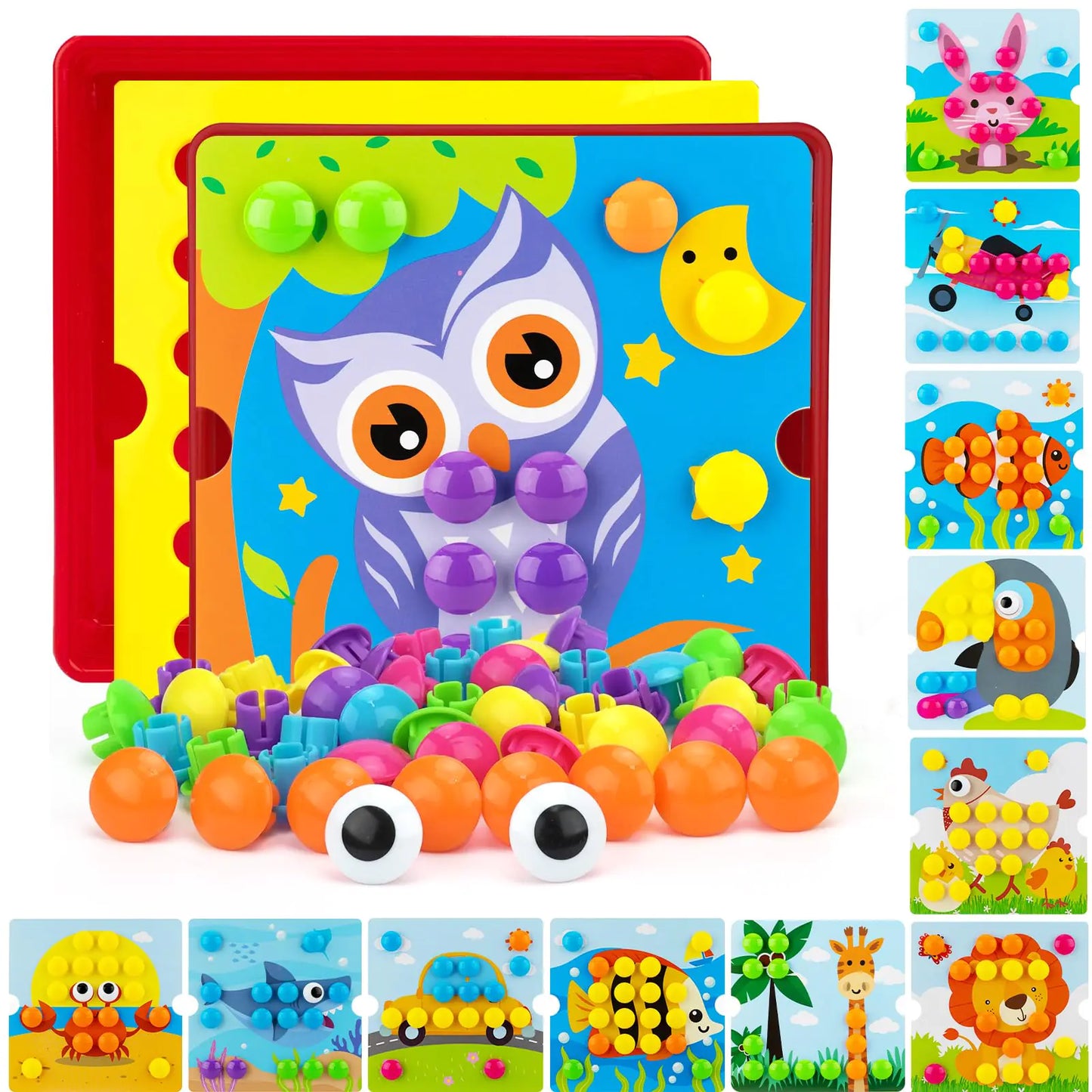I've always been drawn to the Montessori method. It focuses on creating a prepared environment. This environment helps children learn independently and become self-sufficient.

Montessori toys play a key role in this setting. They're made to help kids learn and grow by doing things themselves. By picking the right toys, parents can help their children develop and succeed.
Key Takeaways
- Montessori toys support a child's development and independence.
- A prepared environment is essential for a child's growth and learning.
- Choosing the right toys is critical for creating a Montessori environment.
- Montessori toys promote hands-on learning and exploration.
- Parents can create a nurturing space by selecting appropriate toys.
The Essence of Montessori Education at Home
Dr. Maria Montessori created the Montessori method. It focuses on self-directed learning and hands-on activities. Parents can bring this approach home, creating a supportive space for their child's growth.
Core Principles That Guide Montessori Learning
Montessori education is based on key principles. These include self-directed learning, hands-on activities, and collaborative play. These ideas let children learn at their own pace. Parents can help by creating a learning environment that meets their child's specific needs.
Why the Home Environment Matters as Much as School
The home environment is vital for a child's learning and growth. A Montessori setup at home allows children to practice and improve their skills in a safe environment. Parents can make a child-friendly space that boosts independence and confidence.
In summary, applying Montessori principles at home can have a profound impact on a child's education. By understanding these principles and establishing a supportive home, parents can provide their child with a strong foundation for life.
What Makes a Toy Truly "Montessori"?
Parents seeking to incorporate Montessori principles into their homes should look for authentic Montessori toys. The term 'Montessori' is linked to a learning method that focuses on self-learning and hands-on activities.
Key Characteristics of Authentic Montessori Materials
Real Montessori materials are made with certain qualities in mind. They are usually crafted from natural materials, built to last, and encourage kids to learn on their own. Montessori toys also look good, making kids want to play with them.
Natural Materials vs. Plastic: Making Informed Choices
Montessori toys stand out because of their materials. Unlike many toys made from plastic, Montessori items often use wood, cotton, and metal. These materials offer a real touch and help kids feel connected to nature.
| Material | Characteristics | Benefits |
|---|---|---|
| Wood | Durable, Natural, Aesthetic | Provides tactile experience, connects children with nature |
| Cotton | Soft, Breathable, Natural | Suitable for dolls and other fabric toys, promotes sensory awareness |
| Metal | Durable, Versatile | Used in practical life tools, teaches about different textures and weights |
Single-Purpose vs. Open-Ended Toys
Montessori toys typically have one main goal: to help children focus on a specific skill. However, some toys are open-ended, allowing kids to explore and learn at their own pace. Both kinds of toys are essential in a Montessori setting, helping kids grow in different ways.
In short, a genuine Montessori toy is recognized by its distinctive material, design, and educational objectives. Knowing these traits helps parents choose the right toys for their kids. This way, they can create a prepared environment that supports learning and growth.
The Developmental Benefits of Montessori-Inspired Play
Montessori-inspired play helps parents support their child's growth. It encourages kids to learn on their own, through hands-on activities and teamwork. This approach boosts a child's development in many ways.
Cognitive Skills Enhancement Through Self-Directed Learning
Montessori play allows children to learn at their own pace. This method boosts their thinking skills by teaching them to solve problems and make decisions. For example, puzzles and sorting games challenge their minds and encourage them to think critically and independently.
Fine and Gross Motor Development
Montessori toys and games also improve physical skills. Stacking blocks, pouring water, and dressing frames work on fine motor skills. Running, climbing, and balancing games help with gross motor skills. These activities enhance coordination and physical fitness.
Building Concentration and Focus
Montessori play also helps kids focus better. By doing meaningful and challenging tasks, they learn to concentrate. This skill is key for school success and is developed through engaging Montessori materials.
In summary, Montessori play offers many benefits. It improves thinking skills, physical abilities, and concentration. By incorporating Montessori principles into play, parents can create a child-friendly environment that fosters growth and development.
Montessori at Home: How to Create a Prepared Environment with Your Toys
To foster a love of learning in your child, it's essential to create a prepared Montessori environment. This environment encourages independence and exploration. A well-designed Montessori space can profoundly impact your child's cognitive and motor skill development.
The Five Essential Elements of a Montessori Prepared Environment
A Montessori prepared environment has five essential elements: order, structure, beauty, nature, and freedom. These elements create a space that is both nurturing and challenging.
- Order: A well-organized space that promotes a sense of calm and clarity.
- Structure: A clear and consistent layout that helps children understand the environment.
- Beauty: Aesthetically pleasing materials and decor that inspire curiosity.
- Nature: Incorporating natural elements and materials to foster a connection with the environment.
- Freedom: Allowing children the autonomy to make choices and explore their interests.
Organizing Materials to Promote Independence
Organizing materials in a way that promotes independence is key in a Montessori environment. Use low, open shelving and baskets or containers to store materials. This makes it easy for children to access and return materials, promoting responsibility and self-reliance.
Creating Order and Accessibility
Creating order and accessibility in a Montessori environment is more than just organizing materials. It's about making the space child-friendly and easy to navigate. Use child-sized furniture and ensure materials are within reach.
By incorporating these principles into your home, you can create a prepared Montessori environment. This environment supports your child's development and fosters a love of learning.
Selecting Montessori Toys for Infants (0-12 months)
The first year of a child's life is full of discovery. Montessori toys can make this journey even better. Infants learn and grow significantly during this time, developing their senses and motor skills.
Sensory Development Materials for the Youngest Learners
Infants love things that catch their senses. Toys made from natural materials, such as wood and fabric, are perfect. They feel good to touch and are safe for babies' skin.
For example, a wooden rattle or a fabric ball can grab an infant's attention. It encourages them to explore and learn.
Movement and Coordination Tools for Pre-Crawlers and Crawlers
As infants grow, they become more proficient at moving. Montessori toys that help with movement are essential. Toys like activity gyms or soft blocks help them develop their motor skills, such as reaching and crawling.
These toys help build their muscles and improve their coordination.
Top 5 Montessori Infant Toys Worth Investing In
Choosing the right Montessori toys is a wise investment for your infant's growth. Here are five top picks:
- A wooden activity center with various textures and colors.
- A set of soft, fabric books with different patterns and objects.
- A baby gym with hanging toys that encourage reaching and grasping.
- A set of stacking cups or blocks made from natural wood.
- A sensory ball pit or a set of sensory balls with different textures.
These toys are not just fun. They also lay the groundwork for learning and growth.
Essential Montessori Materials for Toddlers (1-3 years)
The Montessori method emphasizes the use of specialized materials for toddlers. These materials help with thinking and moving skills. For children aged 1 to 3, these tools are crucial to their development, sparking their curiosity and fostering a love for learning.
Practical Life Activities That Build Independence
Practical life tasks are central to Montessori for toddlers. Activities such as pouring, sorting, and dressing enhance fine motor skills and hand-eye coordination. Wooden pouring cups and fabric dressing frames are great examples of tools that promote independence.
Language Development Through Montessori Materials
Language skills are vital for toddlers. Tools like object labeling cards and picture vocabulary books boost their vocabulary and understanding. These materials make learning fun and engaging.
Sensorial Exploration Toys for Toddlers
Sensorial exploration is essential for toddlers. It helps them understand their surroundings. Montessori materials, such as texture balls and sound boxes, stimulate their senses. They encourage exploration and discovery, aiding in sensory development.
Using these Montessori materials in play helps toddlers develop essential skills. Creating a Montessori environment at home is rewarding for parents and children. It fosters a love for learning and independence.
Montessori Toys for Preschoolers (3-6 years)
The preschool years are key for growing in many ways. Montessori toys are very helpful in this regard. They support learning and growing in a fun way.
Math and Numeracy Materials That Make Learning Concrete
Montessori math tools bring abstract ideas to life. For young kids, this means things like number rods and counting beads. These help kids get numbers and how they work.
Number Rods are a great example. They show how numbers grow. Kids can see and feel the numbers, making math more straightforward to understand.
Science and Nature Exploration Tools
Montessori loves science and nature. For little ones, this means cool tools like magnifying glasses and bug catchers. These spark curiosity and wonder.
- Magnifying glasses for observing small details
- Bug catchers for exploring insect life
- Plant care equipment for learning about botany
Cultural and Geography Materials for Expanding Worldview
Montessori also teaches about the world. Kids learn with puzzle maps and globes. These help them see the world in a new way.
| Material | Description | Learning Outcome |
|---|---|---|
| Puzzle Maps | Maps that fit together like puzzles, teaching geography | Understanding of world geography |
| Globes | Three-dimensional representations of the Earth | Concept of the Earth's shape and continents |
| Cultural Materials | Materials that introduce different cultures and traditions | Appreciation for cultural diversity |
Montessori toys help kids learn a lot. They get better at math, science, and understanding the world. Choosing the right toys can be hard, but it's worth it for your child's growth.
Designing Child-Friendly Montessori Spaces in Different Rooms
Creating a Montessori environment is important in every room. As a parent, you can design spaces that encourage independence and curiosity. These spaces should also foster a love for learning.
Creating a Montessori-Inspired Bedroom
A Montessori-inspired bedroom helps your child become independent and self-sufficient. Here are some tips:
- A low bed or a mattress on the floor makes it easy for your child to get in and out.
- A dresser or closet with easy-to-reach storage helps your child dress.
- A calm, peaceful room with soft lighting and simple decor helps your child relax.
Living Room Adaptations for Montessori Play
The living room is a key area for play and learning. Here are some ways to adapt it:
- Set up a child-sized table and chairs for activities.
- Use shelves or storage that your child can access, allowing them to choose their toys.
- Clear a safe area for your child to move and explore.
Kitchen and Bathroom Setups for Practical Life Skills
Practical life skills are key in Montessori. Adapting your kitchen and bathroom helps your child learn these skills.
Some ideas include:
- A step stool or stool for reaching the sink or countertops.
- A child-friendly utensil drawer or a low cabinet for cleaning supplies.
- A bathroom setup with a low sink or a stool for the toilet.
By using these ideas, you can make a Montessori space that supports your child's growth. It will also encourage a love for learning.
Effective Toy Storage Solutions That Promote Independence
In a Montessori setting, toy storage is more than keeping things tidy. It's about helping kids learn independently. A good storage system allows kids to easily find what they need, encouraging them to explore and learn independently.
Low, Open Shelving Systems That Work
Low, open shelving is a key part of Montessori classrooms. It lets kids reach materials without help. When setting up shelving, keep these tips in mind:
- Choose sturdy, low shelves that your child can reach.
- Place materials at eye level for easy access and choice.
- Change out materials regularly to keep things interesting.
Baskets, Trays, and Containers: The Montessori Way
Baskets, trays, and containers are vital for keeping things organized and helping kids learn to do things for themselves. They help sort materials, making it more straightforward for kids to find what they need.
Here are some tips for using them effectively:
- Choose natural materials, such as wicker baskets or wooden trays.
- Label containers so kids know what's inside.
- Pick containers that match the size of what they hold.
Visual Organization Strategies for Young Children
Visual organization is essential in a Montessori classroom. It helps kids understand how things are grouped and makes it easier for them to find what they need.
Here are some ways to organize visually:
- Put similar things together (like all blocks in one spot).
- Use pictures or icons to label categories.
- Keep the area clean to avoid feeling overwhelmed.
By using these toy storage ideas, you can make a Montessori environment that encourages kids to be independent, learn on their own, and enjoy exploring.
Implementing Toy Rotation: Keeping the Environment Fresh
Toy rotation is a simple way to keep your child's space fresh and fun. It keeps them interested and encourages learning and exploration.
The Science Behind Why Toy Rotation Works
Toy rotation works because it taps into our love for new things. Changing toys keeps your child curious in play. It also prevents them from feeling overwhelmed by too many toys, helping them focus on play.
Creating a Practical Rotation System That's Easy to Maintain
To set up a toy rotation, sort your child's toys into groups. Then, make sets of these groups to switch out. For example, you could have sets for sensory toys, practical life items, and cognitive development toys. Keep some sets stored away and switch them out every few weeks.
What to Rotate and What to Keep Constant
Finding the right balance is key. Rotate toys that serve similar educational purposes to keep things interesting. But, keep some things the same, like the play area's layout or favorite toys, for stability and security.
| Rotation Category | Toys Included | Rotation Frequency |
|---|---|---|
| Sensory Toys | Textured balls, sensory mats, play dough | Every 4 weeks |
| Practical Life Materials | Mini brooms, dustpans, pouring cups | Every 6 weeks |
| Cognitive Development Toys | Puzzles, stacking toys, shape sorters | Every 8 weeks |
With a toy rotation system, you can make a dynamic and engaging space. It supports your child's growth and keeps them curious.
Budget-Friendly DIY Montessori Materials
Bringing Montessori into your home doesn't have to be expensive. With some creativity, you can make a learning space that's both fun and affordable.
Montessori emphasizes the use of natural and everyday items for learning. By reusing items you already have, you can create numerous educational activities for your child.
Simple Sensory Activities Using Household Items
Sensory play is a key component in Montessori, enabling children to learn through touch and exploration. You can make fun sensory activities with items like rice, beans, sand, and water.
- Fill a container with rice or beans and hide small toys or other objects for your child to find and explore.
- Create a sensory bin using a plastic container, water, and soap for a fun and educational water play experience.
- Use a tray or container filled with sand and add small toys or other objects for your child to discover and engage with.
Practical Life DIY Projects That Cost Almost Nothing
Practical life skills are essential in Montessori, teaching kids to cook, clean, and take care of themselves. You can make DIY projects from things you already have at home.
- Use a small tray or container and fill it with water, soap, and a sponge for a fun and educational washing activity.
- Create a simple pouring activity using a cup or container and a tray or plate to catch spills.
- Use a small broom or dustpan and teach your child how to sweep and clean.
Upcycling Regular Toys into Montessori-Aligned Materials
You don't need to spend a lot on Montessori materials. By upcycling toys and items, you can make activities that help your child learn and grow.
For example, you can make a Montessori-style puzzle from a regular one. Just use cardboard and a few simple items.
Being creative and resourceful lets you create a Montessori space that's both fun and affordable. With a bit of imagination, you can turn everyday things into valuable learning tools for your child.
Finding Quality Montessori Toys: A Shopping Guide
Choosing the right Montessori toys is key to a prepared environment for learning. As a parent, knowing what to look for is essential. This helps support your child's educational path.
Trusted Montessori Material Suppliers Online
When buying online, pick reputable suppliers for authentic Montessori materials. Look for sites that focus on education and understand the Montessori method. They should provide clear product details and be transparent about their manufacturing process.

Quality Indicators When Shopping for Montessori Toys
What makes a toy truly Montessori? Look for natural materials, simplicity, and a focus on one skill. Stay away from toys with flashing lights or loud sounds. They can be too much for kids.
Investment Pieces vs. Supplementary Materials
Not all Montessori toys are the same. Investment pieces are durable and designed for long-term use, such as a wooden sorting toy. Supplementary materials add variety but might not last as long. Knowing the difference helps you make informed choices.
Balancing Modern Life with Montessori Principles
It's a challenge to mix modern life with Montessori education. As parents, we strive to create a Montessori environment that fosters independence and curiosity. We also face the hurdles of today's world.
Technology and Screen Time in a Montessori Home
Handling technology and screen time is a big task. Montessori focuses on hands-on learning. Here's how to balance it:
- Set limits on screen time
- Pick educational content
- Use tech for creative activities
Navigating Family Gifts and Non-Montessori Influences
Dealing with family gifts and other non-Montessori items can be challenging. Here's what to do with gifts that don't fit Montessori:
- Make them part of learning play
- Guide gift-givers to Montessori items
- Store non-Montessori toys for later
Adapting Montessori for Busy Working Parents
For busy working parents, adapting Montessori means keeping a child-friendly space despite a tight schedule. Here's how:
- Make a safe, accessible environment
- Set routines for independence
- Involve your child in daily tasks
By carefully blending Montessori with our busy lives, we can create a supportive space for our child's growth and happiness.
Common Pitfalls When Creating a Montessori Environment
The Montessori method focuses on self-directed learning. But setting it up at home needs careful thought. A well-made Montessori space is key for a child's growth and independence.
Overstimulation: When Less Truly Is More
One big mistake is overstimulation. Too many toys can confuse a child and make it hard to focus. A clean space allows kids to dive deep into one thing, helping them learn more effectively.
The Balance Between Freedom and Boundaries
Montessori places a significant emphasis on freedom within a framework of rules. It's important to set clear limits, but also let kids make choices. This balance teaches kids about their limits and how to make decisions.
Adult Interference in Child-Led Activities
Another issue is when adults step in too much. It's natural to want to help, but it can hurt a child's confidence. It's better to wait and guide when it's needed, supporting their learning journey.
Recognizing these common mistakes enables parents to create a Montessori environment that fosters their child's growth. It creates a caring and supportive place for them to learn and grow.
Montessori Adaptations for Different Living Situations
Montessori ideas can make any home a child-friendly space for growth. You can set up a great learning area, even in a small apartment or a big house. It's all about using space wisely and making it work for your child.
Small Space Solutions for Apartments and Condos
You don't need a lot of room to create a Montessori space. Here are some play area ideas for tight spots:
- Use wall shelves and storage to save floor space.
- Choose furniture that does more than one thing.
- Make a play zone that can be put away when not needed.
Shared Bedrooms and Play Areas
Sharing a room or play area needs clear rules and good organization. Here's how to do it:
- Split the room into areas for sleeping, playing, and studying.
- Use dividers or curtains to separate spaces.
- Let your child help organize their area to feel more in charge.
Outdoor Montessori Environments
Outdoor areas can also be Montessori-friendly. Here are some ideas:
- Start a garden where kids can grow their plants.
- Set up outdoor play areas, such as climbing structures.
- Go on nature walks to encourage exploration and love for nature.
With these tips, you can make any home a Montessori-inspired environment. It supports your child's growth, no matter where you live.
Observing Your Child: The Key to a Successful Montessori Space
To make a great Montessori space, parents must watch and adjust to their child's needs. Watching your child helps you see what they like, what they're good at, and what they struggle with. This knowledge is crucial for creating an environment that fosters growth.
Signs Your Environment Is Supporting Development
A well-designed Montessori space makes a child happy, focused, and able to work independently. Look for signs like them finishing tasks, staying focused, and seeming joyful.

When and How to Make Adjustments Based on Observations
As you watch your child, you might need to tweak the Montessori space to fit their needs better. This could mean adding new materials, rearranging things, or giving extra help. The important thing is to listen to your child and change things as needed.
| Signs of a Supportive Environment | Adjustments to Make |
|---|---|
| Child is engaged and focused | Maintain the current environment |
| Child is struggling with a particular task | Provide additional support or modify the task |
| Child is bored or uninterested | Introduce new materials or activities |
Documenting Progress and Milestones
Keeping track of your child's growth and achievements is vital. Use notes, photos, or videos to do this. It helps you see how they're doing and where they might need more help. This way, you can make smart choices about their learning.
Conclusion
Creating a Montessori environment at home is a great way to support your child's growth. By using montessori toys and setting up a child-friendly space, you encourage independence and curiosity. This also helps build a love for learning.
A well-thought-out prepared environment is essential. Choose the right montessori toys and organize your home well. This creates a space that invites exploration and discovery. Think about play area ideas that boost movement and creativity. Also, find good toy storage solutions to keep things tidy.
By following the tips in this article, you can make a space that supports and engages your child. Remember, observing and being flexible are important. They help make a Montessori environment truly effective.
FAQ
What is a Montessori prepared environment?
A Montessori prepared environment is a special space. It encourages kids to learn on their own and use their hands. It's designed to meet each child's needs.
How do I choose authentic Montessori toys?
Look for toys made from natural materials. They should be used for one thing only. And they should help kids learn by doing things themselves.
What are the benefits of toy rotation in a Montessori environment?
Toy rotation keeps things interesting and organized. It helps kids learn new things. They get to try out different materials and activities.
How can I create a Montessori environment in a small space?
In a small space, use furniture that does more than one thing. Keep things tidy and use wall space for storage. Make sure it's safe and easy for kids to move around.
What are some budget-friendly ways to create Montessori materials?
Make Montessori materials on a budget by using things you already have. Turn regular toys into Montessori tools. Try DIY projects that align with Montessori principles, such as sensory play and practical life activities.
How do I balance Montessori principles with modern technology and screen time?
Set limits on tech and screens. Focus on hands-on learning. Ensure tech use is educational and not just for entertainment.
What are some common pitfalls to avoid when creating a Montessori environment?
Avoid excessive stimulation and seek adult help. Don't let kids get too distracted. Ensure they can learn and work independently.
How can I observe my child's progress in a Montessori environment?
Watch how well they work alone and focus. See how they grow and develop. Adjust the environment as needed to support their learning and growth.

